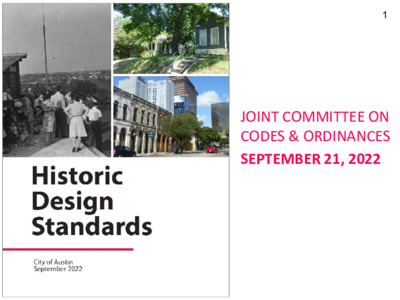Historic Design Standards Presentation — original pdf
Backup

1 JOINT COMMITTEE ON CODES & ORDINANCES SEPTEMBER 21, 2022 DESIGN STANDARDS WORKING GROUP 3 PROCESS SEPT 2018 2019 JUNE 2020 Standards revised; graphics added NOV DEC HLC forms Design Standards Working Group Draft released for community review Working group does deep dive, creates draft UT graduate class surveys national best practices 2 SEPT -OCT DEC 2022 Initiation and recommend. (JSOC, Planning Commission) Review and possible approval by City Council Working group recommends Historic Design Standards; HLC adopts resolution in support Review by: -Planning Commission 12/8/20 -Zoning and Platting Commission 12/1/20 -Downtown Commission 12/16/20 -Design Commission 12/21/20 DESIGN STANDARDS Historic districts 5 Secretary of the Interior’s Standards for Rehabilitation 1. A property will be used as it was historically or be given a new use that requires minimal change to its distinctive materials, features, spaces, and spatial relationships. 2. The historic character of a property will be retained and preserved. The removal of distinctive materials or alteration of features, spaces, and spatial relationships that characterize a property will be avoided. 3. Each property will be recognized as a physical record of its time, place, and use. Changes that create a false sense of historical development, such as adding conjectural features or elements from other historic properties, will not be undertaken. 4. Changes to a property that have acquired historic significance in their own right will be retained and preserved. 5. Distinctive materials, features, finishes, and construction techniques or examples of craftsmanship that characterize a property will be preserved. 6. Deteriorated historic features will be repaired rather than replaced. Where the severity of deterioration requires replacement of a distinctive feature, the new feature will match the old in design, color, texture, and, where possible, materials. Replacement of missing features will be substantiated by documentary and physical evidence. 7. Chemical or physical treatments, if appropriate, will be undertaken using the gentlest means possible. Treatments that cause damage to historic materials will not be used. 8. Archeological resources will be protected and preserved in place. If such resources must be disturbed, mitigation measures will be undertaken. 9. New additions, exterior alterations, or related new construction will not destroy historic materials, features, and spatial relationships that characterize the property. The new work will be differentiated from the old and will be compatible with the historic materials, features, size, scale and proportion, and massing to protect the integrity of the property and its environment. 10. New additions and adjacent or related new construction will be undertaken in such a manner that, if removed in the future, the essential form and integrity of the historic property and its environment would be unimpaired. Historic landmarks + National Register districts DESIGN STANDARDS Historic districts 6 Secretary of the Interior’s Standards for Rehabilitation 1. A property will be used as it was historically or be given a new use that requires minimal change to its distinctive materials, features, spaces, and spatial relationships. 2. The historic character of a property will be retained and preserved. The removal of distinctive materials or alteration of features, spaces, and spatial relationships that characterize a property will be avoided. 3. Each property will be recognized as a physical record of its time, place, and use. Changes that create a false sense of historical development, such as adding conjectural features or elements from other historic properties, will not be undertaken. 4. Changes to a property that have acquired historic significance in their own right will be retained and preserved. 5. Distinctive materials, features, finishes, and construction techniques or examples of craftsmanship that characterize a property will be preserved. 6. Deteriorated historic features will be repaired rather than replaced. Where the severity of deterioration requires replacement of a distinctive feature, the new feature will match the old in design, color, texture, and, where possible, materials. Replacement of missing features will be substantiated by documentary and physical evidence. 7. Chemical or physical treatments, if appropriate, will be undertaken using the gentlest means possible. Treatments that cause damage to historic materials will not be used. 8. Archeological resources will be protected and preserved in place. If such resources must be disturbed, mitigation measures will be undertaken. 9. New additions, exterior alterations, or related new construction will not destroy historic materials, features, and spatial relationships that characterize the property. The new work will be differentiated from the old and will be compatible with the historic materials, features, size, scale and proportion, and massing to protect the integrity of the property and its environment. 10. New additions and adjacent or related new construction will be undertaken in such a manner that, if removed in the future, the essential form and integrity of the historic property and its environment would be unimpaired. Historic landmarks + National Register districts 7 WHY HISTORIC DESIGN STANDARDS? 1. Provide clearer standards for historic landmark owners and National Register district property owners. 2. Provide consistent standards for project review by commissioners and staff. 3. Increase equity by reducing resources required for the historic district application. 4. Increase predictability for property owners in potential districts. WHY HISTORIC DESIGN STANDARDS? 8 5. Provide an educational tool for all historic property owners. 6. Follow good practices in preservation. NOTE: No changes to the historic review process are proposed. 9 PROPOSED CODE CHANGES Clarify standards for proposed projects • • 25-11-213(K) [New subsection] 25-11-243(D) Action on a Certificate of Appropriateness Staff and commissioners should use the Historic Design Standards when making determinations about proposed projects. Make historic district application more equitable and streamlined • 25-2-353(C), 25-2-355(B)(5), 25-2-356(A,B,C) Require compliance with the standards for all historic districts designated after the date of adoption, remove the requirement for district-specific preservation plans, and allow historic districts to create supplements with more specific standards if desired.